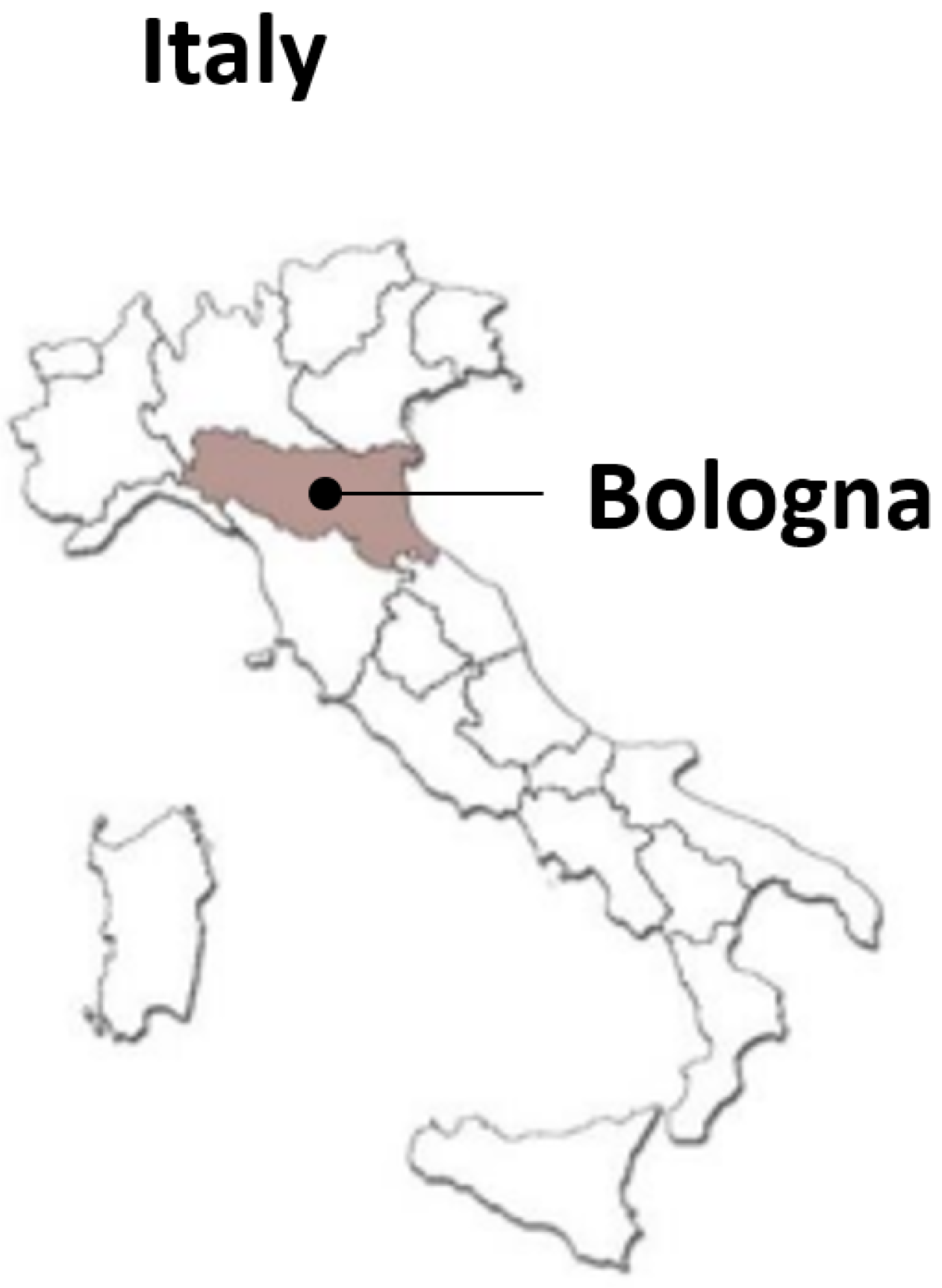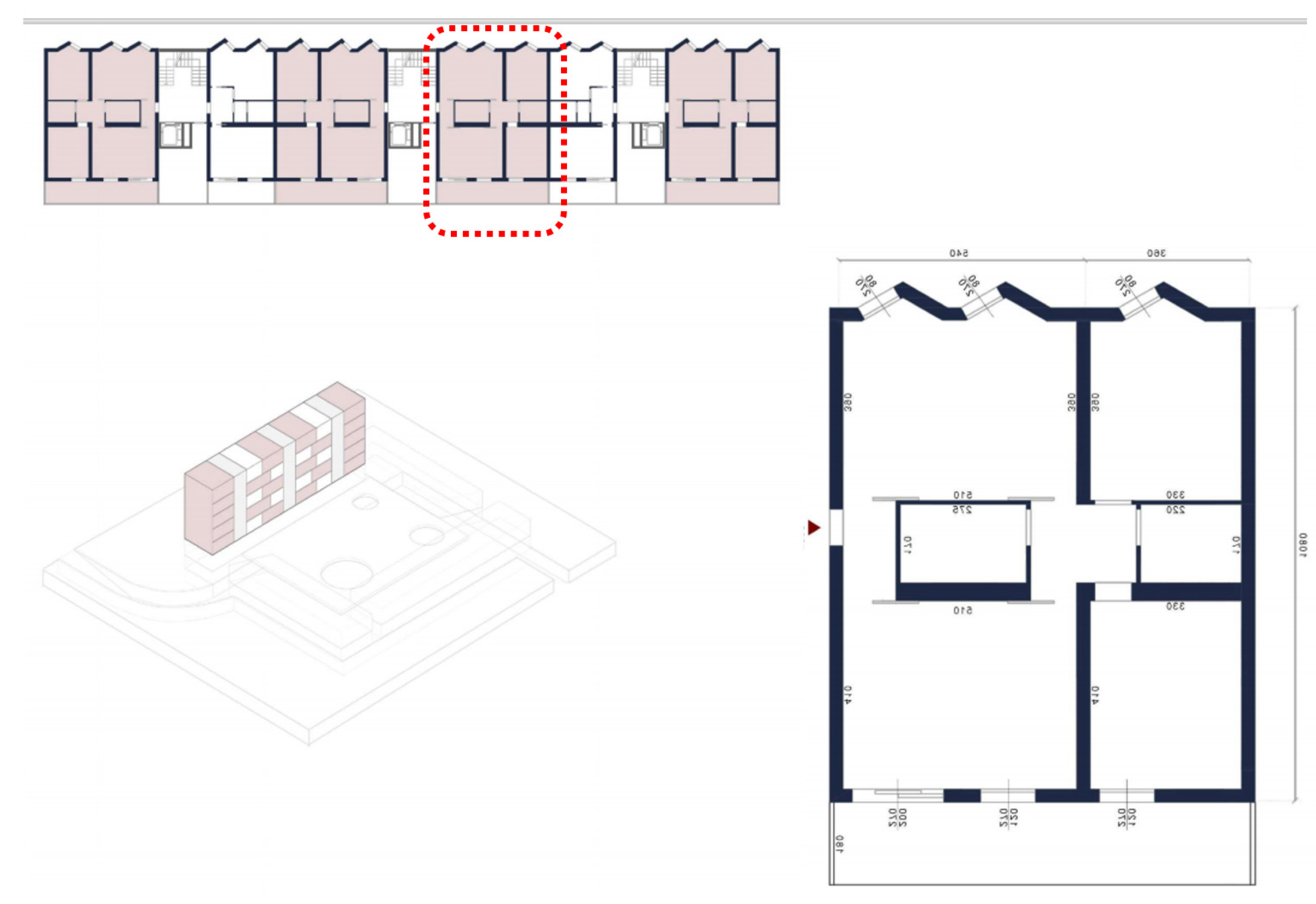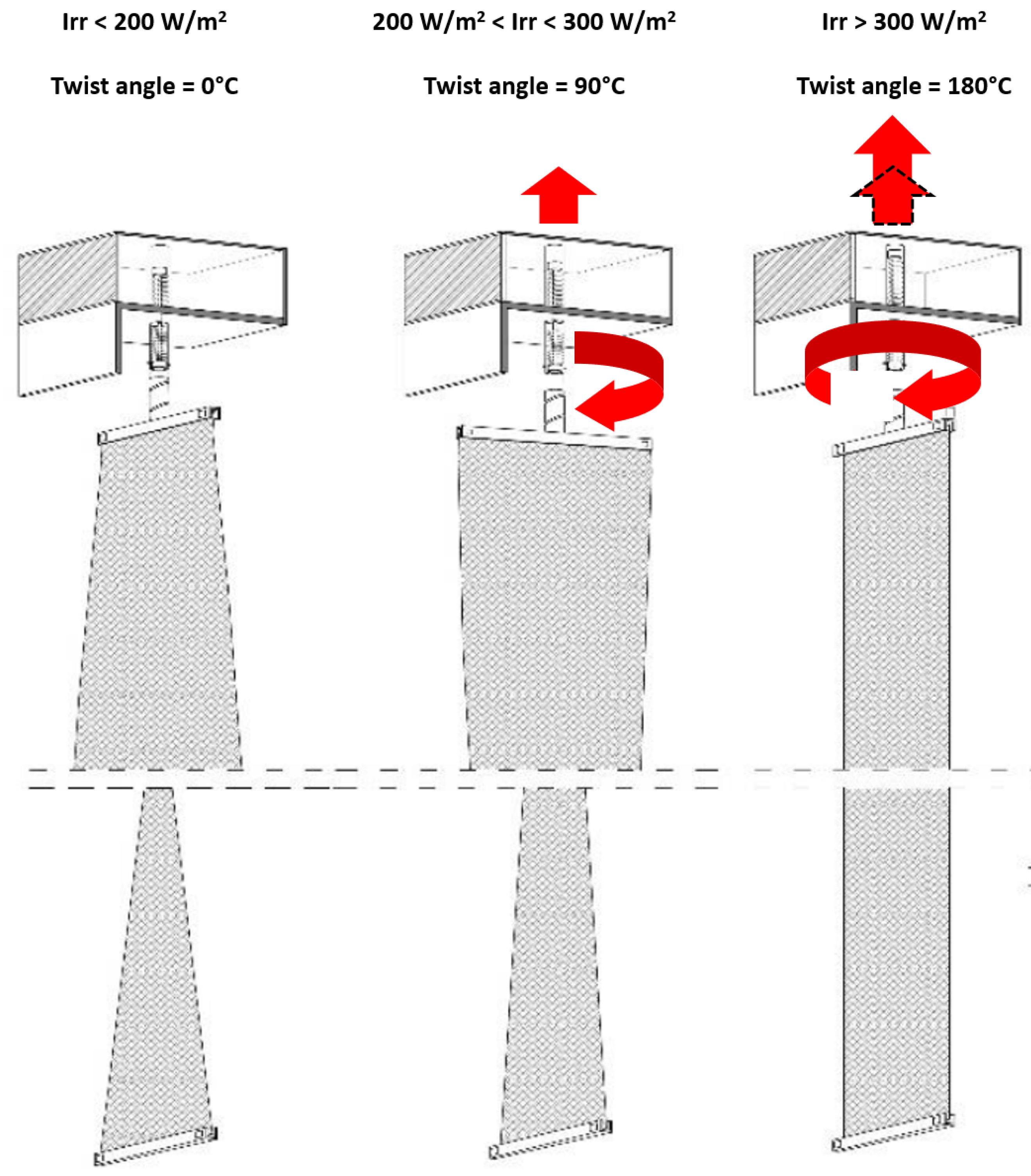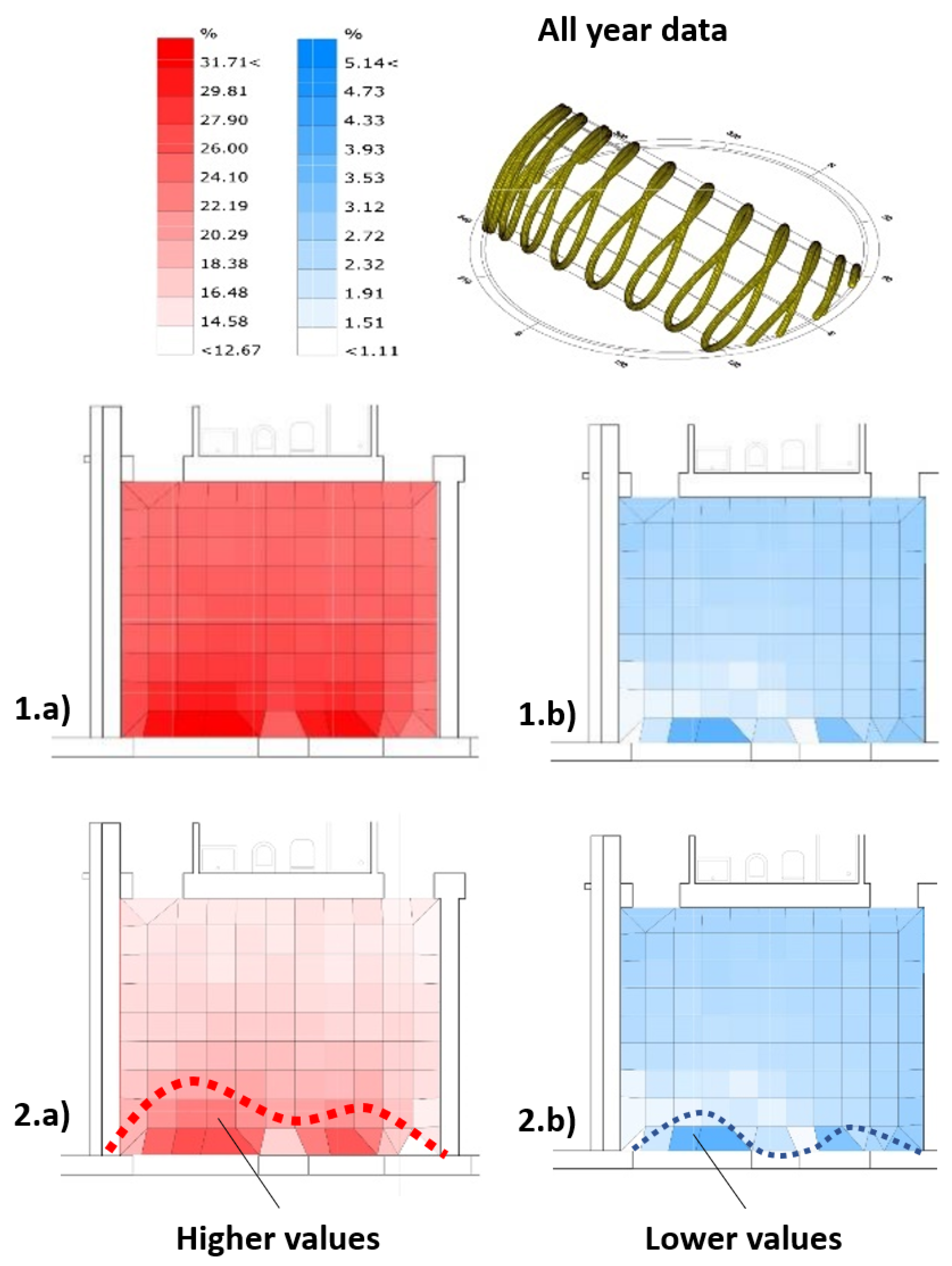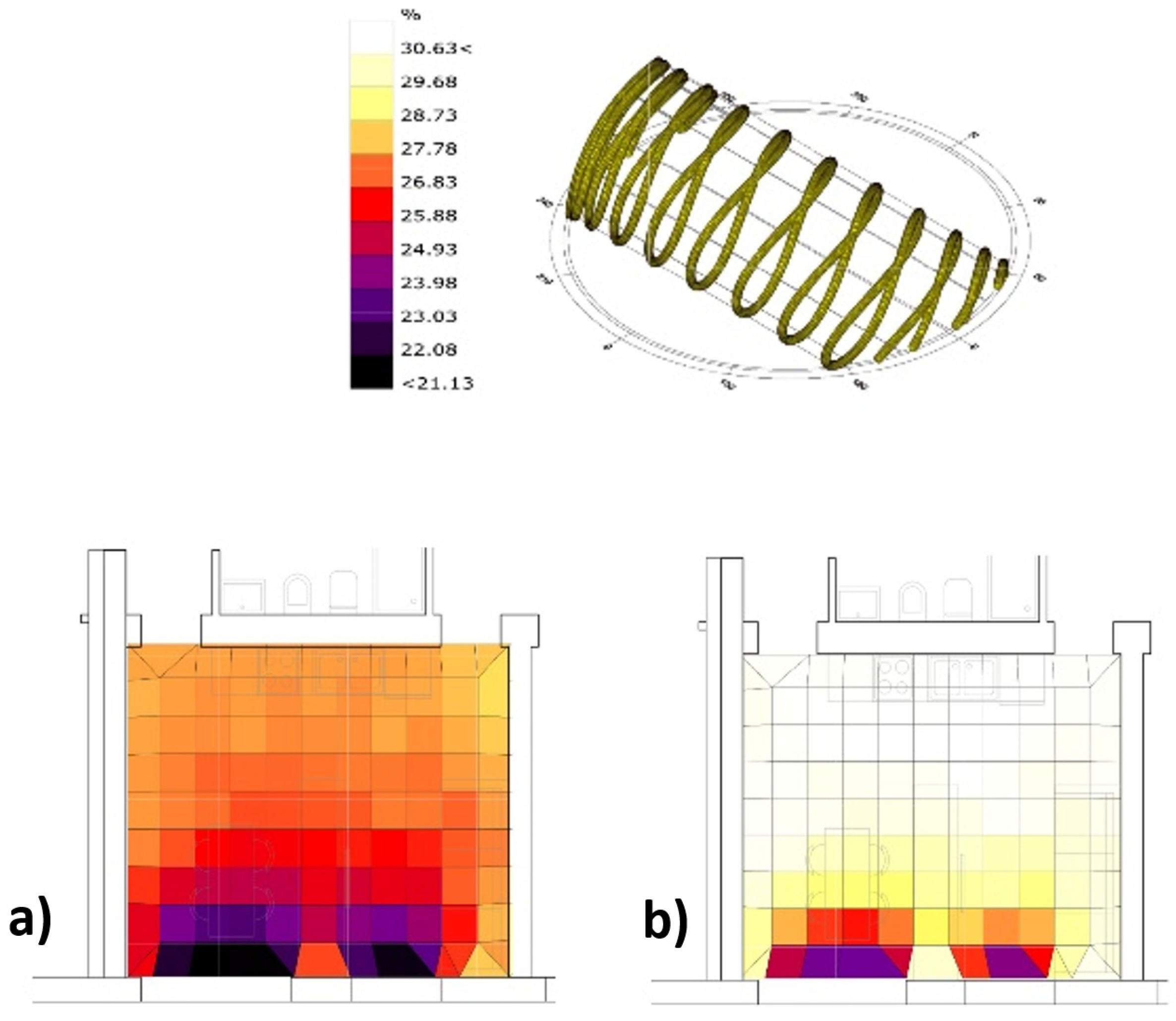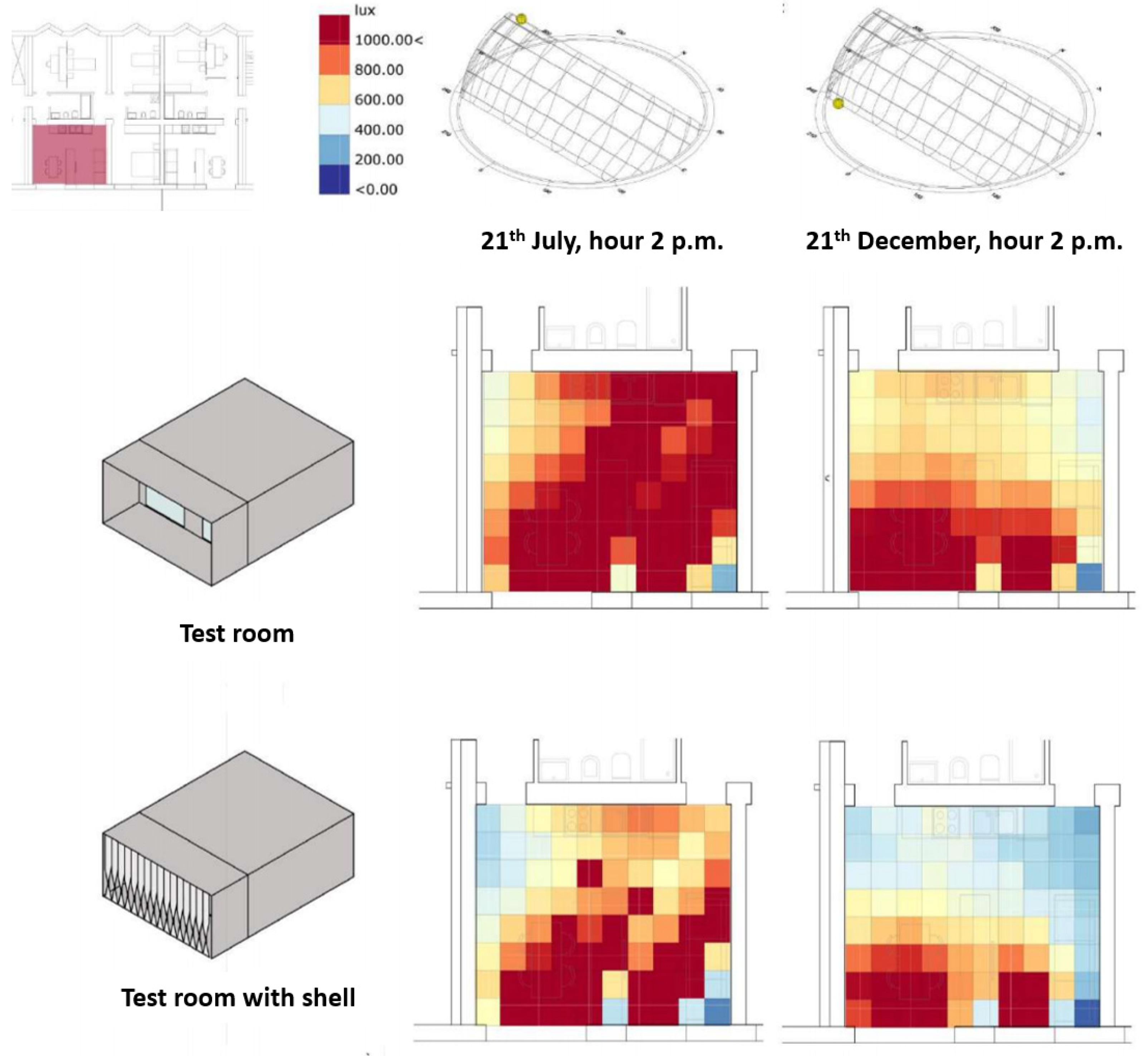1. Introduction and Background
The ever-increasing evidence regarding the potential impacts of climate change on the building sector is strictly related to not only to the recurrence of extreme events, such as heatwaves, flooding, wildfires, but also to the structural alterations of local climate conditions, which affect the population in everyday life and remarkably influence the expected response of buildings and cities [
1,
2,
3].
The 2018 IPCC report “Global warming of 1.5 °C” warned about the potential consequences of temperature increase, considering several interrelated and variable parameters on key sectors [
4,
5,
6], especially those linked to United Nations Sustainable Development Goals [UN SDGs]. The data observations over the last decades showed a relevant increase in the average temperature in many cities in different regions and a related growth of energy demand for air conditioning (AC) can be easily detected both in terms of intensity and diffusion across the EU and other countries [
7,
8].
Additional studies have been provided by the scientific community to explore the sector-based analyses of energy demand and supply options to achieve a large reduction in GHG emissions: Creutzig [
9], Jacobson [
10], and Clack [
11] analyze a 100% renewable energy transition by 2050. However, most of the investigated measures differ for several reasons, such as political and socio-economic implications, and they are often randomly adopted within the same country without having a clear perspective of the extent to which the conditions will evolve in the future. The broad scientific literature documents the achievements gained in meeting the highest expected standards in terms of energy savings; however, it also reveals the minor attention given to the interrelated phenomena and citizens’ wellbeing; see Ferrao and Fernandex [
10] and European Environment Agency [
12]. Meanwhile, other studies specifically focused on the mitigation strategies to cope with more specific issues, such Urban Heat Island [UHI] [
13,
14,
15].
Nonetheless, despite the huge efforts made in recent decades to develop effective measures to support the transition towards a low-carbon society, as described in European Commission Environment Directorate-General [
15], in 2015, the level of greenhouse gases [GHG] in most of the projections will show a dramatic rise in the coming years [
16].
Therefore, the progressive understanding and awareness raised about climate change and sustainable development are leading to calls for groundbreaking and innovative design approaches in architecture [
17,
18,
19,
20] to concretely contribute to facing this huge challenge.
A wide range of architectural solutions developed in recent years mainly focus on decreasing the demand for heating [
21], and adopting more efficient insulation material and systems to comply with the Energy Performance of Buildings Directive [
22], the EPBD Recast III [
23] and the Directive 2012/27/EU [
24]. However, the achievement of a building sector which is more resilient to future climate conditions [
25,
26] also requires the appropriate decisions about orientation, as well as effective mitigation solutions, exploiting both natural ventilation and shielding options against overheating.
Among the possible answers to these issues, the use of the so-called adaptive solutions [
27] (able to change their configuration according to the variation of temperature or solar radiation) [
28] can be considered very promising solutions to reduce the thermal load on the building envelope.
The scientific literature groups these solutions into the family of climate-adaptive building shells (CABS) which can be classified according to different criteria, from the climate response to the activation agent, and from their geometrical configuration to the adopted actuator. Their common element is that the system is essentially designed to dynamically vary the façade configuration as a response to environmental changes according to the detection of specific parameter variations [
29].
1.1. CABS in the Scientific Literature
Designed to primarily meet a sustainable design in terms of provided performances, the very first generation of CABS was mainly based on electro-mechanical actuators driven by a centralized CPU, which processes the outdoor condition variations [
30,
31,
32,
33].
This enables a real-time optimized response to external variations and does not require any manual action to be performed by the end users, although this limits the end user’s own preferences.
The development of the so-called smart materials are defined as: “A material which has built-in or intrinsic sensor(s), actuator(s) and control mechanism(s) whereby it is capable of sensing a stimulus, responding to it in a predetermined manner and extent, in a short appropriate time and reverting to its original state as soon as the stimulus is removed” [
34]. The smart materials enlarged the opportunities of kinetic characterization [
35].
Much more relevant are the deriving solutions, which are generally highly responsive and can be considered energetically autonomous, concretely contributing to the development of innovative low-energy design concepts with very limited mechanical devices. The more frequently used deriving solutions are: magnetorestrictive materials, piezo electric materials, shape-memory polymers, phase-change materials, photochromic glasses, and shape-memory alloys. These materials can be used as actuators to passively drive the shielding system due to their own capacity to autonomously and reversibly adapt to climatic variations without computerized remote control. This typology remarkably reduces several maintenance and economic problems related to electro-mechanical solutions.
Passive systems typically react to environmental parameters such as temperature, humidity, and light, etc., providing an instant response to their variations. Some studies [
17] consider the use of smart materials as no longer separable from adaptive building envelope design, supported by advances in technologies, production methods and simulation capacities.
When the adaptive capacity is an intrinsic feature of the building envelope sub-system and does not require an external decision-making component, it is usually classified as an intrinsic control system, self-adjusting according to temperature, humidity, light, and stimuli, etc. [
27,
36], providing a classification via the related energy (radiant, thermal, potential, and kinetic). Depending on the properties of materials and on their responsiveness to the environmental stimuli, technological solutions can be classified with several nuances: unpowered kinetic [
36], energy-free adaptability [
37], zero-energy adaptability [
28], and auto-reactive [
36] or intrinsically controlled adaptability [
29].
For the scope of this study, the more inclusive definition of the self-sufficient kinetic building envelope [
38], referring to both the capacity to autonomously control the dynamism and the independence from supplied energy sources, is adopted.
The passive actuators, more frequently adopted in the current market, are those based on bi-metallic components, a change of state wax and shape-memory springs. This study investigates the use of shape-memory springs, defined with the acronym SMA: “shape-memory alloy”, with a relation to two intrinsic advantages of these materials: the pseudo elasticity and the shape-memory effect. This type of spring is composed of two elements, nickel and titanium, commonly called nitinol, and responds to temperature variations through an elongation of 10%. The shape-memory effect (EMS) allows SMAs a dual process that combines a stored physical shape with a transition from a malleable to a rigid state.
At room temperature, SMAs, in the martensitic phase, are malleable and can be bent into various shapes; when heated at a certain temperature they reach the austenitic phase, becoming rigid and remembering their stored shape [
39].
1.2. CABS Based on a Shape-Memory Alloy
Shape-memory alloys (SMAs) have a dual solid phase actuated by a specific environmental trigger. In the first phase the material is inert and easily deformed. In the second phase it recovers the initial molecular structure and the related shape that can be set “at will” according to a predefined layout. This is achieved through a “training” process of the phase transition that can also influence some mechanical characteristics of the material such as stiffness.
SMAs ensure the advantage of an on-off function, which behaves like a switch that allows a specific configuration to be obtained. However, the main problem often lies in creating the counteraction bias to bring the actuator back to its original shape [
40,
41].
The main limitation of such intrinsically controlled systems is that they cannot be directly controlled by the occupants, influencing the satisfaction level. A dedicated study [
42] pointed out that this is not connected with thermal comfort (which is generally achieved) but mostly with visual requirements, as the optimization of the shading element positioning often reduces external views from the interior. The other relevant limitation deals with the system’s responsiveness, which is “programmed” during the fabrication process which cannot be changed during the time. This capacity is tuned during the design process, making the system dependent on the precise environmental parameters fluctuation.
The actuator can be localized, meaning that the kinetic component has an actuator triggering a pre-defined movement, or can be distributed, meaning that the system has several actuators. A combination of several actuators, intended as the mean to move the system components, can of course increase the kinematic complexity.
2. Goals
The scope of the study is to develop and test a methodology to evaluate the effectiveness of adaptive façade solutions during the preliminary design stage, with relation to indoor microclimate conditions: temperature, thermal comfort, and daylight. The proposed methodology is then applied to a shielding solution based on SMA technology. In the following section the methodology, calculations and output are described, followed by a case study application. The same process can be replicated with other adaptive options, which compare the different performance levels and the possible effects on the façade.
3. Methodology
This study provides a rapid and comparative methodology to assess the impacts of shielding systems in terms of energy and lighting levels. The related workflow includes three different typologies of input data regarding: (a)
climate data: to properly consider the context in which the system is expected to operate; (b)
building configuration: to adequately consider the influence of geometry and architectural choices and possibly define a representative standard room to be adopted as test room; and (c)
building shell design: to set the geometrical and technical features of the system. The use of a standard virtual test room allows for the investigation of several variations, limiting the complexity of interaction for replicating the process and extending the results to a full-scale building when one (or more) specific solution(s) is selected.
Figure 1 provides a graphical representation of the workflow.
With reference to the geometrical characteristics of the system, the following configuration options must be considered: totally shading the solution, partially shading the solution, simply filtering the solution. The rotation angle and the incident solar radiation must also be carefully taken into account. The standard virtual test room is modeled to be adiabatic, with no energy exchange with surrounding spaces except for the façade, n, for which the shielding system is installed. Internal walls have a reflection coefficient equal to 0.90 corresponding to a white plaster and a very similar floor finishing. The standard virtual test room is designed like a physical test laboratory.
The definition of the thermophysical properties of the shielding system is very dependent on its design and this is strictly connected with the architectural concept which underlines the design, as well as with the choice of the actuator, which can be based on an electromechanical device or on SMA component, as in the specific case study. Once these elements are preliminary decided, the related data are input for the model in Grasshopper, the software adopted for simulation purposes. As is the standard with most simulation processes, a check phase is required to assess the input/output data accuracy and reliability before the results can be successfully obtained.
The other relevant part of the process deals with the activation rules that influence the dynamism of the shielding system (if any) and may depend on the daytime, the lighting level, the indoor/outdoor temperature, or other factors. In the case of SMA, which is adopted for the demo case study, the activation criterion is the outdoor temperature, which determines the rotation angle based on the incident solar radiation. Depending on the rotation angle, the percentage of obstruction of the incoming solar and luminous radiation is defined for the shielding element and the indoor microclimate (temperature, illuminance, and radiation, etc.), for the standard virtual test room varies accordingly.
The final stage of the process deals with the simulation output which is intended to support a more detailed and in-depth design of the shielding system and actuator, once the preliminary choices are addressed. The simulation output regards:
- (A)
Overheating/underheating hours: the simulation allows the evaluation of the response with respect to comfort expressed as Predicted Mean Vote (PMV);
- (B)
Thermal Comfort Autonomy: measures the percentage of hours of the year that fall within the comfort parameters, without the aid of heating and cooling systems;
- (C)
Radiant temperature: measures the radiant temperature in °C at a specific time of the year, through points of a grid built inside the 3D room under study. The radiant temperature influences local thermal comfort and discomfort conditions;
- (D)
Parametric Daylight Analysis: it provides the illuminance level (lux) to evaluate the correct natural lighting of the interiors.
4. Case Study
In this section the proposed methodology is concretely applied to a case study for testing purposes on a building at the design stage, located in the city of Bologna (
Figure 2). The building is under development and a specific study to achieve the highest efficiency and comfort level is required to support the design process during the different stages.
Bologna is a city located in the mid-northern part of Italy, (lat. 44.31 N, long. 11.17 E), in the middle of the Po valley. Following the Koppen classification [
43,
44], the weather is a Humid Subtropical Climate(Cfa) and it is characterized by a range of latitudes from 20° to 35°. It is mildly cold in winter and hot and sunny in summer, with weak wind and focused rain occurring particularly during the autumn and spring seasons.
4.1. Building Design and Test Room
The case study is a free-standing residential building with a south-oriented main façade (
Figure 3) where the living area of all the flat typologies is located. The overall shape is a quite compact and has a regular volume, with east-oriented bow windows on the north side and wide loggias along the entire length of the south side. The 1.8-m depth of the loggia partially shades the largely glazed façade during the summer period to avoid overheating, while ensuring a suitable solar gain during winter. However, without any shielding element, loggias cannot be used during the summer due to the exposure and high temperature of the location. Additionally, the south orientation may cause unsuitable glaring effects regardless of the loggia proportion. Therefore, during the preliminary design stage, the opportunity to add a shielding system was discussed and then which of the available options would best fit the design brief requirements was explored. During the preliminary discussion, some concern about the possible reduction in natural lighting and the possible user difficulties with managing the actuation mechanism emerged. This led to a chance to concretely apply the proposed methodology to select the most appropriate solution and optimize its configuration. After a preliminary evaluation, a self-sufficient solution was agreed upon (to avoid any energy dependency and to make the shielding system operating) and an SMA-based actuator was chosen, as described in the following paragraphs, to meet both the architectural design ambition and the expected indoor comfort levels.
The standard virtual test room corresponded to the living room of a typical flat and was 5.10 m wide and 4.10 m long with an internal net height of 2.70 m. The loggia had a depth of 1.8 m (
Figure 4).
4.2. Building Shell
The investigated adaptive shell solution is a frontal shielding screen of metal mesh aimed at filtering the incident solar radiation.
Figure 5 shows the different shielding system configurations according to the different rotation angles of its vertical axis and the related effects on light inflow. The choice of using a metal mesh is mainly due to the façade orientation and the need to filter solar radiation, letting only part of it enter into the loggia. At the same time this material ensures an adequate resistance to the rotation impressed by the system’s dynamism and offers less resistance to wind pressure on the façade surface (reducing the structural sections); despite this, the latter factor is not at the core of the present study. The use of rotating screens is to meet architectural preferences and does not influence the methodology testing process, which can be replicated with any other technical option. Specifically, in this case study, the torsion allows the element to shift from a flat configuration, parallel to the façade, to one in which its upper part is rotated 180°. This ensures a free visual perspective from the indoor spaces and the loggia. Furthermore, compared to other systems based on a rigid movement, the torsion of a light element requires less energy for system implementation and perfectly fits into passive actuation systems, which allow a change of configuration without the contribution of energy from the grid.
Therefore, the lower weight, less material, and lower energy required to activate the torsion are the key design elements which emerged during the decision-making process and led to adopting a “passive” activation system.
4.3. Activation Rules
The chosen activation system is an actuator operating by means of two springs, one of which is a shape-memory alloy (SMA) positioned inside a “thermal box” (Milan Polytechnic patent) [
45,
46]. The upper end of the system is positioned on the actuator, while the lower part is fixed and keeps the shielding module under tension. When the shape-memory spring is elongated due to heating (at an air temperature of 25 °C and thermal chamber temperature of 50 °C), it is in its original form and causes the actuation system to move upwards. This upward movement is transformed into rotation by pins, which move a cylinder with a spiral hole to which the single façade module is connected. In this state, the shielding system assumes the maximum shielding configuration and covers 100% of the surface. When the temperatures decrease, even within the same day, the spring (in the martensitic phase) becomes malleable and is compressed downwards. The lower spring increases its elongation at the same time, causing a downward movement of the system, which means that the actuator triggers a rotation of the cylinder to which the shielding module is connected. This, albeit gradually, reaches a rotation of 180°. The rotation of the actuation system corresponds to a torsion of one end (in our case the upper end) of each shielding module.
The system is activated in relation to the external temperature and the solar radiation that comes into contact with the thermal box. The SMA spring stretches with a radiation of 300 W/m2, which corresponds to a temperature of about 50 °C, and reaches inside the metal box with a dark glass in which the spring is placed. The box allows the spring to reach higher temperatures than those corresponding to current outdoor conditions.
With the solar radiation on a vertical plane higher than 300 W/m
2 (and beyond) the spring stiffens and overcomes the tension of the normal spring, recovering the original shape. The system transforms the compression generated by the spring into a rotational movement by means of a notched rod which transmits the axial force to a flange making it rotate. The ropes are attached to this latter element which rotates when the flange assumes a cylindrical configuration (maximum shielding in conditions of high incident radiation) or an hourglass configuration (opening the maximum possible area below the activation threshold). The system and possible shielding configurations are shown in
Figure 6.
5. Outcomes
The following paragraphs summarize and comment on the outcomes of the application of the proposed methodology, as obtained by Grasshoper software according to the output listed (A-B-C-D) in
Section 3.
5.1. Overheating
The simulation output shows the number of hours, expressed as a percentage, during which the indoor temperature is higher or lower than the standard value, conventionally fixed to 20 ° C and the PMV comfort condition is equal to zero; therefore, representing a neutral comfort.
The results (
Figure 7) show that the percentage of hours of overheating, in red, are about 30% (evidencing that the distribution is very close to the windows) with a significant positive reduction compared to the condition without shielding. For underheating, in blue, the lowest value is around 5%. In other words, in a building with an adaptive façade, the need for cooling energy decreases at approximately 30% less than the value during the summer and the heating energy requires a minor reduction of 5% during the winter season.
In terms of the activation of the shielding during the year, this controls and ensures solar gains during the winter regime (blue) and attenuates the solar radiation inflow during the summer regime (red).
5.2. Thermal Comfort Autonomy
The simulation output dealing with Thermal Comfort Autonomy (TCA) (
Figure 8) allows an evaluation of how many hours, as a percentage, the environment is able to ensure the conditions of thermal comfort without activating any heating/cooling systems.
Figure 8 shows that this percentage is around 25%, meaning that for approximately 25% of the hours during a year it is necessary to activate the heating or cooling system to keep the building air conditioned.
5.3. Radiant Temperature
The output represents the distribution of the average radiant temperature value, expressed in degrees centigrade, within the room.
Figure 9 reports the results for a representative day, in this specific case 5 August at 3 pm, which was selected as it was the peak day during the heat waves of summer 2018, and historically one of the hottest days of summer in Bologna.
The role of the façade in reducing the radiant temperature is evident, with a more marked approximate decrease of 3–4 °C near the window (
Figure 9).
5.4. Daylight Analysis
The output displays the distribution of illuminance, measured in lux, within the building environment on 21 December and 21 July at 2 pm analyzing the configurations with and without shielding.
The results show that at 2 pm, both during the winter and summer solstices, the unshielded room shows an excessive level of lux, almost exceeding 1000 lux on the entire surface. By applying the shielding, this exceeding level of illumination is dimmed and generally remains at a satisfactory level. In summer conditions, the external cantilevered balcony largely intercepts the solar radiation that reaches the room’s windows. However, the application of the shielding does not negatively affect the general conditions, having a value higher than 300 lux across almost the entire surface (
Figure 10).
6. Discussion
The diffusion of adaptive façades in contemporary architecture is currently quite limited due to different factors. On the one hand, operating costs and maintenance costs are often generally considered unsustainable in the mid- to long-term; however, these factors can be greatly reduced by adopting self-sufficient systems such as SMA and avoiding the use of electro-mechanical systems. On the other hand, a common level of uncertainty is perceived around their real effectiveness, particularly during the early design stages.
Adaptive solutions are often driven by architectural and aesthetic choices, aiming to make the sustainable attributes of the building visible, rather than by their real performances and potential impacts on users’ wellbeing. The very limited availability of methods or tools, in common design practice, to observe and evaluate the potential effects of adopting an adaptive solution, led to the exploration of a methodology, based on relatively simple steps, to support the fast preliminary evaluation of the adaptive façade performance. This led to the development of a feasible and reliable workflow whose results allowed for the assessment of the achievable performance level that, in the case of an SMA solution, based on a passive system, was adopted. However, this is not to be considered a foregone conclusion. The passive actuator significantly reduced the maintenance cost while optimizing the use of services and comfort levels with remarkable energy savings (which were not the specific focus of this article), but sometimes did not meet the users’ preferences whose customization level was limited (override is often possible, but negatively affect the overall performance). Thus, having a clear projection of the potential effects, benefits and limitations during early design stages could be very helpful in addressing the architectural choices using an approach that best fits the investor and target users’ expectations.
The advantages of the proposed method deal with a significant reduction in the time required to evaluate the potential effects and benefits of adopting the adaptive façade solution to the single investigated unit, according to a multidimensional approach regarding energy, comfort, and daylight. The conducted study demonstrated that the proposed methodology and the related outcomes could be successfully replicated in further research and design activities. Limiting the analysis to the single investigated unit could be considered a weakness of the study, but this approach was based on the same concept of a laboratory test: once the sample unit and the specific performance to be investigated were selected, the process allowed the selection of the most promising options. Yet, it was still necessary to deepen their behavior at the building scale in a further stage. This meant improvements and additional details could be explored without significantly changing the selected technologies.
According to the specific concept, CABS required a simulation phase, which was performed during the construction design phase and the proposed method avoided a time- and resource-consuming process which applied to multiple options. It was discovered only at the end of the flow that many of these options did not fit the scope properly.
The proposed methodology refers to the very preliminary design stage when there is a choice to apply a CABS, as well as a typology, and is still under discussion. It can be observed that the proposed methodology does not focus on the potential influence of the surrounding buildings, which is discussed in a second stage when the choice concerning the appropriateness of the solution is made. Furthermore, CABS are usually adopted to protect the façade in case of direct insulation, considering that the narrow construction of the urban fabric is not able to provide any kind of direct or indirect shading.
7. Conclusions
The proposed methodology can be easily applied to any kind of adaptive façade and the required resources and time can be considered as compatible with design activities and comparable to other consultancy typologies. This study required some additional time and resources due to the trial and error phase, but, once the workflow was fixed, the process could be replicated in a relatively smooth way. The adopted perspective was to reduce the effort required, focusing on a significant (recurrent) portion of the building to investigate the potential effect and scaling up of the outcomes, in order to obtain a reasonable projection of the effects on the overall building performance during the preliminary design, saving time and money. Once one or more options were explored and the suitable option was identified, the solution could be detailed and modelled to the entire building for construction purposes.
The study contributes to the building energy performance and building comfort with reference to adaptive solutions, which can provide a valuable response to the effects of climate change if applied to the retrofitting actions on existing buildings. These can also be included in policy recommendations for renovation actions, as well as new building initiatives. The current literature review, as well as the authors’ previous studies in this filed [
19], demonstrate that research and prototyping are particularly active in this sector. However, the concrete application of the tested pilots still remains episodic in the current conventional market due to two main reasons. On the one hand the technological solutions are often quite sophisticated and sometimes not cheap (this was the case during the 1960s with the first curtain wall applications). On the other hand, the effort, time and the costs of simulations during the early design stage still affects the decision-making process.
The adoption of rapid methods for achieving a comparative multidimensional approach to selecting the most appropriate options, can significantly reduce the required time and, consequently, can facilitate the diffusion of adaptive solutions with a potentially progressive cost reduction. Since this happened in the past with ventilated façades, it may also happen with adaptive façades considering that the frontiers of architectural design are very close to creating a building capable of sensing the surrounding environmental conditions and adapting to them, optimizing users’ comfort and livability.

